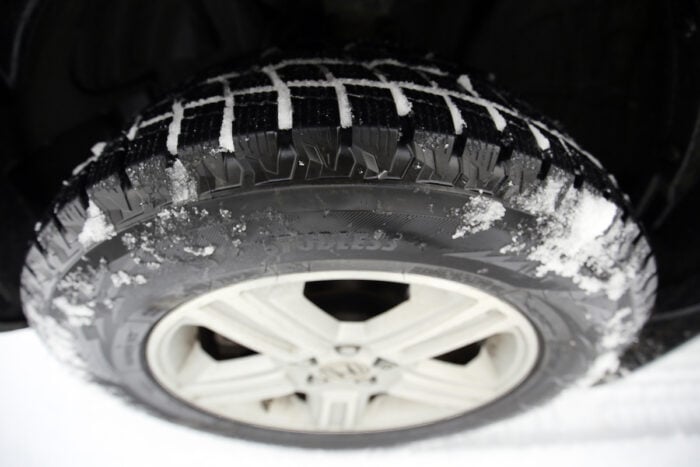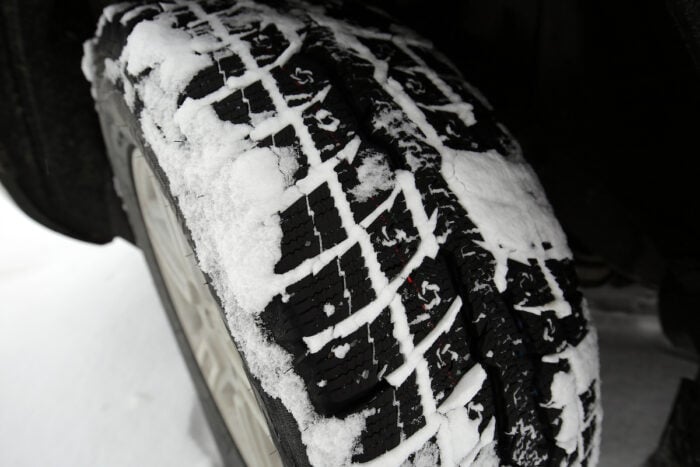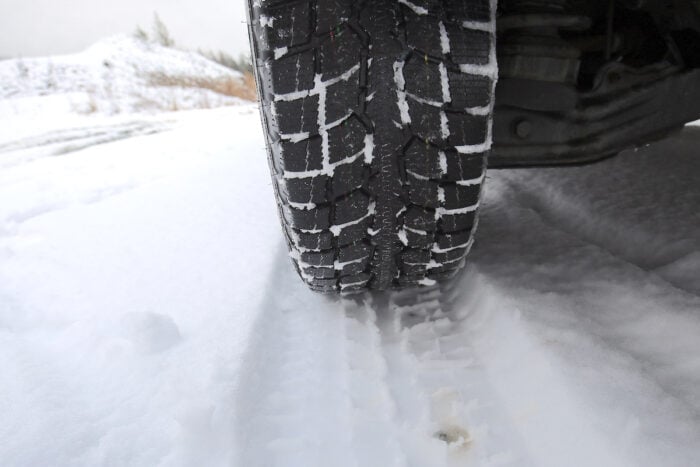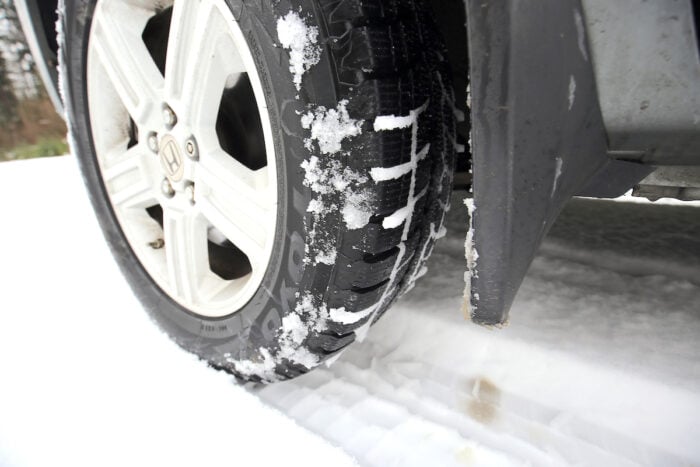I had the opportunity to evaluate one of Toyo’s latest winter tire offerings last winter, and I came away thoroughly impressed. The Toyo Observe GS-i 6 is a stud-less performance tire that has been designed and engineered to provide light trucks and sport utility vehicles with surefooted traction and ride comfort.
After spending a little more than four months with these fitted to my truck I came away feeling that this tire is perfectly suited for the ever changing weather and road conditions that characterize, in this instance, a harsh Canadian winter.
Quick Specs:
- Type: Premium winter tire
- Replaces: Observe GSi-5 and Observe Garit KX
- Vehicles: Passenger cars, vans, SUVs, and light trucks
- Tread Pattern: Directional or asymmetric (may vary by size)
- Tread Depth: Varies by tire size
- Speed Rating: Varies by tire size (typically H or T)
- Load Index: Varies by tire size
- Warranty: Toyo’s limited warranty
Quick intro: how we tested the Toyo Observe GSi-6 Winter Tires
The tires were fitted to a low-mile, first-generation Honda Ridgeline by professional installers. The truck had recently been given a new suspension and brakes, and a four-wheel alignment was performed shortly after the new tires were fitted.
I live in British Columbia, Canada, and our regulations require that you operate your vehicles with a proper winter tire (or chains) from October 1 to March 31. Still, many highways through mountain passes or high snowfall areas extend this period to April 30.
Due to complications related to the Covid-19 pandemic, the tires went on a little later than expected, but I did manage to run them for a period beginning in late December until the end of April. During this test period, I managed to put 2,485 miles or 4,000 kilometres on the tires in various road, weather, and terrain conditions.
First impressions of the premium Toyo winter tires
The first thing I noticed about the Observe GSi-6 is that they were really smooth running and quiet. Before these, I was running a set of Cooper Discoverer A/TW tires that had served me well for several years, but that model has a much more aggressive all-terrain tread design, which tends to create a substantial amount of road chatter at speed.
The Toyo Observe GSi-6 may be the quietest dedicated winter tire that I have experienced, and given the number of press vehicles (of all shapes and sizes) that I have had the opportunity to test on winter rubber, this is a pretty impressive claim for the Toyos.

Taking the Toyo Observe GSi-6 Winter Tire on a long-distance drive
I like to begin a tire test with a long-distance run of at least 310 miles or 500 kilometres and my recent pattern has been to make the journey up the twisty Fraser Canyon to Spence’s Bridge, followed by a 37 mile / 60 kilometre sprint along Highway 8 as it undulates beside the Nicola River through rolling hills and past scenic hoodoos.
From Merritt I take Highway 5A to Princeton, before following the Crowsnest Highway back to Hope and then finally using Highway 7 to make my way home to the Fraser Valley. This trip can be a challenge for a tire any time of the year as the road surfaces are irregular and get beaten up by heavy truck traffic and plows. Add to this the fact that the sudden elevation and weather changes typical of mountain passes can wreak havoc on both traction and braking abilities.
During the course of my day-long journey, the Toyo Observe GSi-6 tires performed flawlessly despite being asked to navigate over rough roads at highway speeds. They faced a deluge of rain between Agassiz and Hope, but the GSi-6’s tread pattern proved very adept at evacuating standing water from beneath the tire.

This is accomplished through a combination of wide grooves and sipes that provide an efficient means for excess water and slush to be cleared away so that the tire can retain grip with the road surface.
I like to use this route to evaluate performance cars as it offers an incredible mix of twists, turns, dips, and dives, and in the winter, these conditions will quickly reveal the inherent strengths and weaknesses of a tire. The Fraser Canyon was slick and icy in areas where the road was sheltered from sunlight, and some areas beyond the tunnels had obviously been neglected by the road crews as a deep blanket of fresh snow was beginning to obscure the highway.
The Toyos relentlessly pushed forward and I found that they climbed and cornered with confidence, and managed to maintain traction with relative ease. The journey from Spences Bridge to Merritt was harrowing at times due to tremendous crosswinds that seemed to surge through the valley and over the river, but my nerve and visibility were tested more than the tires which continued to cut through the slush and snow.

As I made my way to Princeton along Highway 5A I started to see vehicles that had been abandoned alongside the road due to worsening conditions, mechanical failure or driver error. The sugar beet de-icing treatment that is used on many of this region’s highways was obviously in need of a refresh so I did feel a little sliding under braking in a few less travelled sections of the road, but as this section is largely flat, it served as a reminder to maintain my focus rather than inducing much concern.
Around Princeton the road had developed a thick crust of packed snow and ice with two distinct wheel channels cut through to the surface by large truck traffic. As the temperature dropped these deep grooves become slick and can easily trap the tires of a passenger vehicle guiding its direction of travel and robbing the driver of some control.
I elected to ride with my wheels running on the dirty snow surface that resides above and parallel to these channels. This is because this narrow plateau retains a healthy dose of the gravel and sand that is deposited by the highway crews whenever winter creeps in with a sudden dumping of snow.
The Toyo Observe GSi-6 tires handled this challenge without drama, as the high-grip silica compound seemed to bite into the soft surface allowing the truck to motor through without packing the tread with frozen debris and ice. I was left in full control of the vehicle and could steer, corner and brake as needed with just the occasional correction.

Wet Weather Performance
Vancouver is known for its mild climate, so unless you travel to the mountains or interior regions of the province, your winter driving experience will involve more rain than snow. However, late-night temperatures will often dip below the freezing level so icy streets can become a substantial risk and potential hazard.
During my evaluation, I experienced rain almost daily, and the Toyos seemed to thrive in the wet. Hydroplaning was virtually non-existent, and braking distances seemed to be on par with those exhibited when operating on my all-season tires. I did notice that there was less noise coming from my wheel wells than there had been with my Cooper tires, which means that the Toyos seem to expel the water outwards better than the Coopers which spray the inner liners like a pressure washer.
Gravel Performance
The Toyo Observe GSi-6 has been designed to serve primarily as a highway tire and has been manufactured using a compound that should deliver decreased rolling resistance, extended mileage, and long tread life. However, light truck and SUV owners often find the need to venture off paved roads and explore – as I did on several occasions during my time with these tires.
The Sasquatch Mountain Resort is a family-oriented winter sports facility that is accessed by a tight, poorly maintained service road that is covered predominantly in gravel. A seemingly endless series of switchbacks and unstable shoulders make travel on this road a stress-inducing activity on busy ski weekends.
People tend to carry too much speed on this road, especially while descending, leading to aggressive skidding and sliding when the brakes are locked up on the loosely packed surface. For some reason, this road eats Jeeps, and one might begin to believe that the large evergreen trees are reaching out to pluck them from the road. The reality is that most of these rigs are running on all-terrain tires that are not well suited to winter conditions, and the treads pack full of gravel, snow, and ice, transforming them into toboggans.
The Toyo Observe GSi-6 navigated the mountain road with confidence when partnered with four-wheel-drive, and the tread seemed to scamper over the gravel and carve through the snow like a mountain goat as long as I was consistent on the throttle and steady with the pace. I took my time on the descent, preserving my brakes for the slow turns and emergencies, and the tires seemed to be able to resist trapping stones in the tread. In short, the Observe GSi-6 conquered Sasquatch Mountain.
Takeaway: is the Toyo Observe GSi-6 worth it?
After 2,485 miles / 4,000 kilometres and a season of use, I can say that the Observe GSi-6 has proven to be an exceptional tire for the mild winter conditions we get here on the west coast.
Its overall performance was consistent with ride quality, traction, handling, and braking, no matter the conditions. I would confidently recommend it as a winter replacement tire for most light trucks and utility vehicles.



